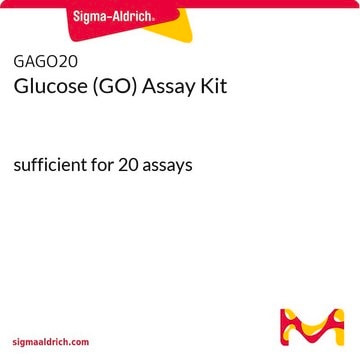The supplier advises that they have not yet validated any lysis buffers for use with cell samples in conjunction with this kit. Additionally, they recommend using an untreated, clear, flat-bottom plate for colorimetric measurements. Therefore, it would be preferable to transfer the samples to such a plate for running the assay.
MAK317
Sorbitol Dehydrogenase Assay Kit
sufficient for 100 colorimetric tests
Sélectionner une taille de conditionnement
634,00 $
Sélectionner une taille de conditionnement
About This Item
634,00 $
Produits recommandés
Méthode de détection
colorimetric
Maladie(s) pertinente(s)
endocrinological disorders, diabetes; gastrointestinal diseases
Température de stockage
−20°C
Catégories apparentées
Description générale
Caractéristiques et avantages
Adéquation
Principe
Mention d'avertissement
Warning
Mentions de danger
Conseils de prudence
Classification des risques
Eye Irrit. 2 - Flam. Liq. 3 - Met. Corr. 1 - Skin Irrit. 2 - STOT SE 3
Organes cibles
Respiratory system
Code de la classe de stockage
3 - Flammable liquids
Point d'éclair (°F)
75.2 °F - closed cup
Point d'éclair (°C)
24 °C - closed cup
Faites votre choix parmi les versions les plus récentes :
Certificats d'analyse (COA)
It looks like we've run into a problem, but you can still download Certificates of Analysis from our Documents section.
Si vous avez besoin d'assistance, veuillez contacter Service Clients
Déjà en possession de ce produit ?
Retrouvez la documentation relative aux produits que vous avez récemment achetés dans la Bibliothèque de documents.
-
What are the recommended methods for homogenizing or lysing cells in a 96-well plate for the MAK317 Sorbitol Dehydrogenase assay kit? The manual advises against using proteolytic enzymes and suggests using a rubber policeman, which is not suitable for a 96-well plate. Are there any recommendations for a mild lysing buffer with minimal impact on the assay outcome? Additionally, is it possible and recommended to run the assay in the same 96-well plate, or is transferring the samples to a new plate necessary?
1 answer-
Helpful?
-
Active Filters
Notre équipe de scientifiques dispose d'une expérience dans tous les secteurs de la recherche, notamment en sciences de la vie, science des matériaux, synthèse chimique, chromatographie, analyse et dans de nombreux autres domaines..
Contacter notre Service technique







